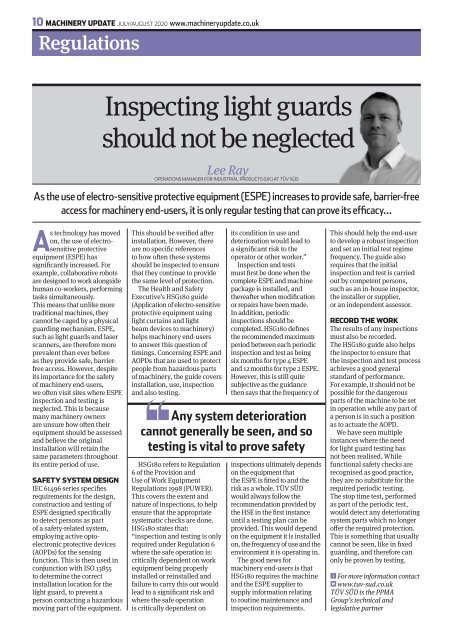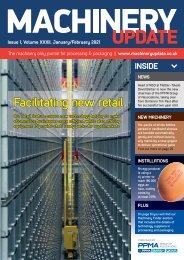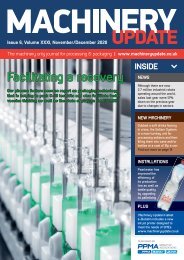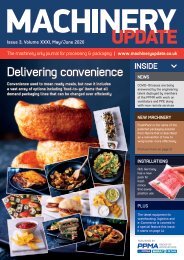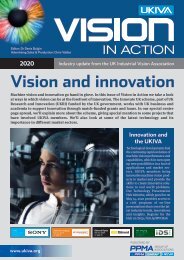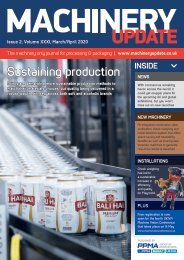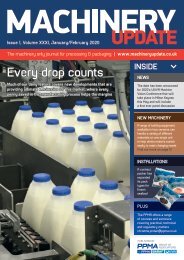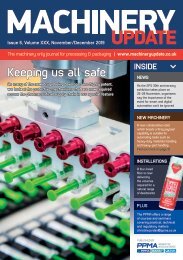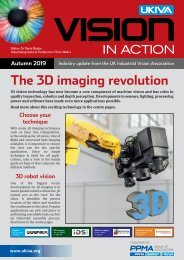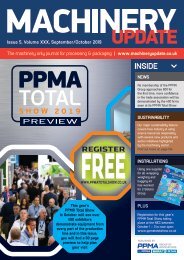Machinery Update July / August 2020
The July / August 2020 issue of Machinery Update.
The July / August 2020 issue of Machinery Update.
- No tags were found...
You also want an ePaper? Increase the reach of your titles
YUMPU automatically turns print PDFs into web optimized ePapers that Google loves.
10 MACHINERY UPDATE JULY/AUGUST <strong>2020</strong> www.machineryupdate.co.uk<br />
Regulations<br />
Inspecting light guards<br />
should not be neglected<br />
Lee Ray<br />
OPERATIONS MANAGER FOR INDUSTRIAL PRODUCTS (UK) AT TÜV SÜD<br />
As the use of electro-sensitive protective equipment (ESPE) increases to provide safe, barrier-free<br />
access for machinery end-users, it is only regular testing that can prove its efficacy…<br />
As technology has moved<br />
on, the use of electrosensitive<br />
protective<br />
equipment (ESPE) has<br />
significantly increased. For<br />
example, collaborative robots<br />
are designed to work alongside<br />
human co-workers, performing<br />
tasks simultaneously.<br />
This means that unlike more<br />
traditional machines, they<br />
cannot be caged by a physical<br />
guarding mechanism. ESPE,<br />
such as light guards and laser<br />
scanners, are therefore more<br />
prevalent than ever before<br />
as they provide safe, barrierfree<br />
access. However, despite<br />
its importance for the safety<br />
of machinery end-users,<br />
we often visit sites where ESPE<br />
inspection and testing is<br />
neglected. This is because<br />
many machinery owners<br />
are unsure how often their<br />
equipment should be assessed<br />
and believe the original<br />
installation will retain the<br />
same parameters throughout<br />
its entire period of use.<br />
SAFETY SYSTEM DESIGN<br />
IEC 61496 series specifies<br />
requirements for the design,<br />
construction and testing of<br />
ESPE designed specifically<br />
to detect persons as part<br />
of a safety-related system,<br />
employing active optoelectronic<br />
protective devices<br />
(AOPDs) for the sensing<br />
function. This is then used in<br />
conjunction with ISO 13855<br />
to determine the correct<br />
installation location for the<br />
light guard, to prevent a<br />
person contacting a hazardous<br />
moving part of the equipment.<br />
This should be verified after<br />
installation. However, there<br />
are no specific references<br />
to how often these systems<br />
should be inspected to ensure<br />
that they continue to provide<br />
the same level of protection.<br />
The Health and Safety<br />
Executive’s HSG180 guide<br />
(Application of electro-sensitive<br />
protective equipment using<br />
light curtains and light<br />
beam devices to machinery)<br />
helps machinery end-users<br />
to answer this question of<br />
timings. Concerning ESPE and<br />
AOPDs that are used to protect<br />
people from hazardous parts<br />
of machinery, the guide covers<br />
installation, use, inspection<br />
and also testing.<br />
HSG180 refers to Regulation<br />
6 of the Provision and<br />
Use of Work Equipment<br />
Regulations 1998 (PUWER).<br />
This covers the extent and<br />
nature of inspections, to help<br />
ensure that the appropriate<br />
systematic checks are done.<br />
HSG180 states that:<br />
“inspection and testing is only<br />
required under Regulation 6<br />
where the safe operation is:<br />
critically dependent on work<br />
equipment being properly<br />
installed or reinstalled and<br />
failure to carry this out would<br />
lead to a significant risk and<br />
where the safe operation<br />
is critically dependent on<br />
its condition in use and<br />
deterioration would lead to<br />
a significant risk to the<br />
operator or other worker.”<br />
Inspection and tests<br />
must first be done when the<br />
complete ESPE and machine<br />
package is installed, and<br />
thereafter when modification<br />
or repairs have been made.<br />
In addition, periodic<br />
inspections should be<br />
completed. HSG180 defines<br />
the recommended maximum<br />
period between each periodic<br />
inspection and test as being<br />
six months for type 4 ESPE<br />
and 12 months for type 2 ESPE.<br />
However, this is still quite<br />
subjective as the guidance<br />
then says that the frequency of<br />
Any system deterioration<br />
cannot generally be seen, and so<br />
testing is vital to prove safety<br />
inspections ultimately depends<br />
on the equipment that<br />
the ESPE is fitted to and the<br />
risk as a whole. TÜV SÜD<br />
would always follow the<br />
recommendation provided by<br />
the HSE in the first instance<br />
until a testing plan can be<br />
provided. This would depend<br />
on the equipment it is installed<br />
on, the frequency of use and the<br />
environment it is operating in.<br />
The good news for<br />
machinery end-users is that<br />
HSG180 requires the machine<br />
and the ESPE supplier to<br />
supply information relating<br />
to routine maintenance and<br />
inspection requirements.<br />
This should help the end-user<br />
to develop a robust inspection<br />
and set an initial test regime<br />
frequency. The guide also<br />
requires that the initial<br />
inspection and test is carried<br />
out by competent persons,<br />
such as an in-house inspector,<br />
the installer or supplier,<br />
or an independent assessor.<br />
RECORD THE WORK<br />
The results of any inspections<br />
must also be recorded.<br />
The HSG180 guide also helps<br />
the inspector to ensure that<br />
the inspection and test process<br />
achieves a good general<br />
standard of performance.<br />
For example, it should not be<br />
possible for the dangerous<br />
parts of the machine to be set<br />
in operation while any part of<br />
a person is in such a position<br />
as to actuate the AOPD.<br />
We have seen multiple<br />
instances where the need<br />
for light guard testing has<br />
not been realised. While<br />
functional safety checks are<br />
recognised as good practice,<br />
they are no substitute for the<br />
required periodic testing.<br />
The stop time test, performed<br />
as part of the periodic test,<br />
would detect any deteriorating<br />
system parts which no longer<br />
offer the required protection.<br />
This is something that usually<br />
cannot be seen, like in fixed<br />
guarding, and therefore can<br />
only be proven by testing.<br />
i For more information contact<br />
W www.tuv-sud.co.uk<br />
TÜV SÜD is the PPMA<br />
Group’s technical and<br />
legislative partner


